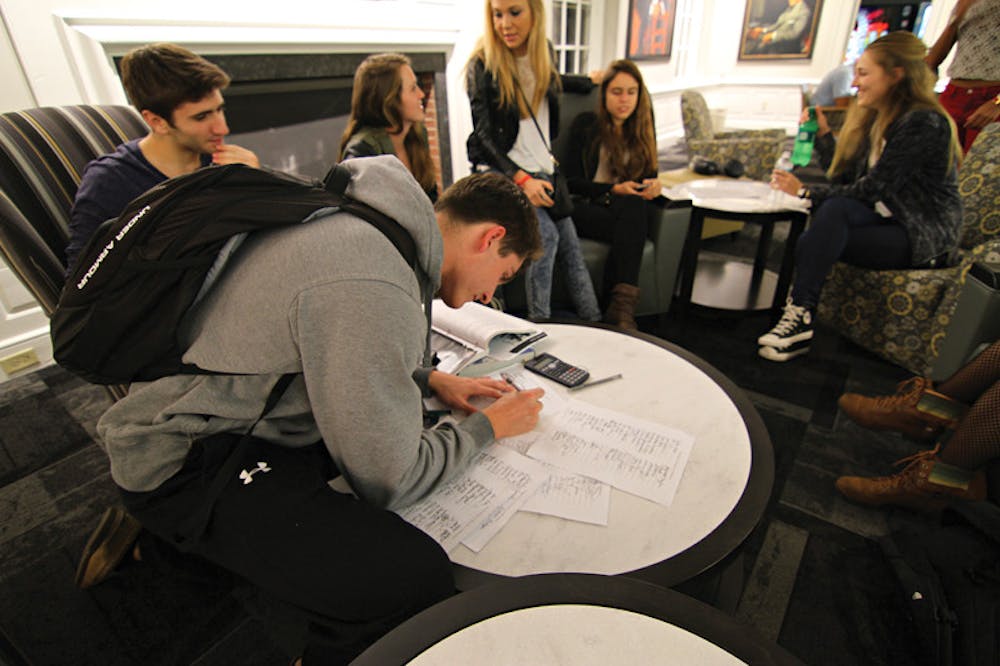About 350 first-years have signed a petition asking University administrators to re-grant Keeney Quadrangle residents access to all three Keeney houses.
This year was the first year Keeney — once contiguous, with all houses accessible to all Keeney residents — was split into three buildings. Residents can now only swipe into their own houses from outside and cannot travel between houses inside.
The change was part of $56 million in housing renovations approved by the Corporation in February 2012 and was intended to foster more intimate relationships among residents in each house, The Herald previously reported.
Sam Barney ’12, who served as Residential Council chair when the Corporation approved housing renovations, said at the time that Keeney felt “too big and impersonal.”
Jacob Kirschenbaum ’17 posted the petition, entitled “Declaration of Keeney Unification,” on the Class of 2017’s Facebook page Sunday evening to garner support.
“It’s time for us to take charge of our first-year living experience,” Kirschenbaum wrote in the Facebook post, offering time slots for first-years to sign the document in Arnold Lounge Sunday and Monday evenings.
The goal of the petition is not to acquire a particular number of signatures, Kirschenbaum said, but to begin a “discussion between administration, students and faculty about the policy and what we can do to change it.”
The petition’s first draft was “originally just written as a joke,” said Adam Alpert ’17, who co-wrote the document with Kirschenbaum, Dan Boulanger ’17 and Oliver Hirt ’17. “But we found that there was validity to our argument, so a couple of days later we hashed out (the document),” Alpert added.
In the declaration, the authors questioned the reasons for not allowing Keeney residents to access all of the quadrangle buildings, expressed concern over the absence of an elevator in Everett-Poland House and asked the University to evaluate the “closed door policy” — a term the authors coined to describe the lack of internal access between buildings.
The final document sparked a campus-wide dialogue among first years, Alpert said, adding that the petition has received support from members in all three Keeney houses and residents of Pembroke campus.
The declaration claims that “the introduction of locked doors, separating the once united houses … has led to the social fragmentation and increased isolation within the respective residential houses.”
“I’d love to meet everyone in Keeney and get the Keeney experience that everyone talks about where you can just wander and meet people,” Kirschenbaum said.
Kirschenbaum said he has met some first-years who support not granting Keeney residents swipe access to all three Keeney houses, though he said it was “a very small number.” First-years who opposed the petition were concerned about “a loss of privacy and calm,” he said.
Some first-years said they do not feel particularly affected by what the petition calls a “closed door policy.”
“Perhaps I would have made different friends if the policy wasn’t in place, but I can’t say whether I would have been happier or not,” said Samantha Savaun ’17, who lives in Archibald-Bronson House. “Any policy should be reconsidered if a large portion of those affected disagree with it.”
All of the co-writers of the document live in either Everett-Poland or Jameson-Mead houses. “The fact that we’re all from similar places shows that’s the real problem here,” Alpert said, adding that they should also know residents of other Keeney houses.
“I think the policy to keep the buildings closed off in the beginning was great … but I think it has sort of run its course,” Kirschenbaun said.
Emily Schell ’16 said she believes the renovations have improved community quality. When she was a first-year living in Keeney, “it was very impersonal and … we didn’t have smaller communities like Perkins,” she said.
Schell now serves as a Residential Peer Leader in Archibald-Bronson and said the first-years in her hall are very close.
“They’re happy with the floor dynamic,” she added.
Marion Wellington ’16, an RPL in Everett-Poland, said her “unit is very tight, and I don’t know if that would have happened if doors had been open.”
The emergency exit doors between Keeney houses that prevent access between buildings seems to have contributed to a significant decrease in first-years needing emergency medical services, Schell said.
Wellington said there have been a lot fewer “shenanigans,” including fewer exit signs broken compared to when she was a first-year in Keeney.
“Last year there were people who ran around and caused mayhem, in a destructive way, and now that the doors are closed, I haven’t seen that as much,” Wellington added.
One concern the Keeney renovations did not address was the lack of an elevator in Everett-Poland, according to the petition.
The “closed door policy” inhibits the ability of students with physical handicaps to “fully socialize with their fellow classmates,” the document states.
The lack of an elevator in Everett-Poland combined with no access to the other buildings “makes part of Keeney inaccessible to a portion of the student body,” Kirschenbaum said. “That (argument) is stronger than the social argument,” he added.
“The Office of Residential Life reviews card access with the Residential Council, and they make a recommendation regarding any changes they feel would be best for students,” wrote Matthew Gill, community director for Keeney, in an email to The Herald. Re-evaluations can occur at anytime, he wrote.
The co-authors plan to continue collecting signatures throughout the week and then send their declaration to Gill and Director of Residential Experience for ResLife Natalie Basil, Alpert said.

ADVERTISEMENT




